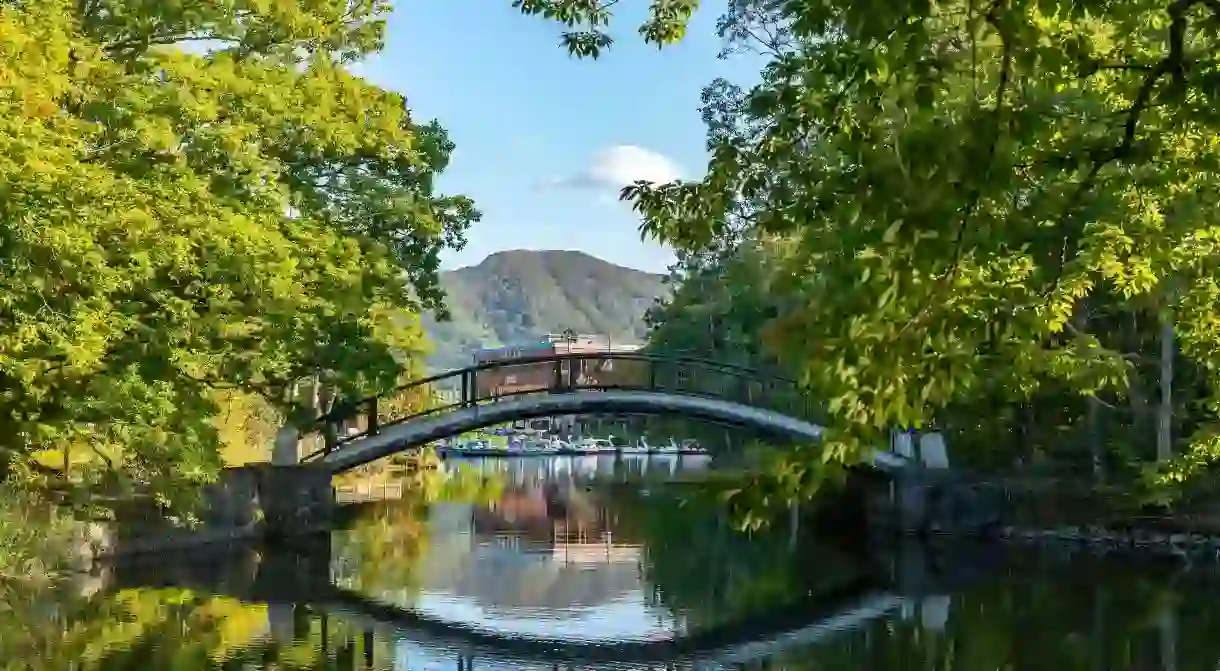Healing Onsens, Castles and Mountains: These Are the Best Day Trips From Hakodate

In the shadow of a mountain and on the shores of the sea, Hakodate is the southern gateway to the frost-bitten island of Hokkaido. And while the city itself deserves a place on any itinerary, a smorgasbord of day trips also sit on its doorstep.
The country’s northernmost Japanese castle. An onsen on the ocean. Volcanoes looming over lakes and peering over the Pacific. Cruises across the Tsugaru Strait to Honshu. And immaculate gardens on the outskirts of the city. Hot springs, herring and the Heishi rock — these are the eight best day trips to take from Hakodate, Japan.
See the sakura bloom at Matsumae Castle
Two hours’ drive southwest of Hakodate, this fortress represented the northern border of Edo-period Japan when the Matsumae clan built it in 1606 – a feudal outpost on the frosty frontier island of Hokkaido. Matsumae Castle was destroyed many times over the centuries before a replica was reconstructed in 1960, surrounded by more than 10,000 cherry trees covering 250 varieties – this is one of Japan’s premier sakura spots each spring. The town is also home to temples, ancient artefacts and the Matsumaehan Yashiki historic theme park beneath its towering centrepiece.

Fish for wakasagi at Onuma Quasi-National Park
This reserve is designated as a quasi-national park, which is no slight on its breathtaking natural beauty, particularly when Mount Komagatake’s reflection shimmers in the water. Onuma is defined by two lakes – Onuma (large lake) and Konuma (small lake) – dotted with tiny islands that are linked by charming bridges, breaking the stroll into bite-sized chunks. The park can also be explored by bike or canoe in summer, while fishing for tiny wakasagi is a winter favourite. Express trains stop at Onuma Koen station half an hour north of Hakodate, making it one of the most accessible day trips from Hakodate on this list, as well as a convenient pit stop on the journey further north to Sapporo (another three and a half hours on the train).

Visit fishing port Esashi
Esashi is the town that herring built. Seventy kilometres (43mi) west of Hakodate on the Sea of Japan, this fishing port boomed in the 18th and 19th centuries – and the merchants who made a fortune built a row of residences along the Inishie Road that remain standing today. The Nakamura family’s old home is one of these time capsules, with four main houses capturing the grandeur of the glory days. Esashi – supposedly named after an indigenous Ainu word for edible kelp – also shows off old ships, quaint shrines and Kamome Island, the port’s natural breakwater featuring the iconic above-water Heishi rock.

Hike to the summit of Mount Esan
This rugged, rocky, rough-hewn volcano spews out sulphur alongside sweeping vistas over the Pacific Ocean. With a paved trail ascending the 618 metres (2,028ft) to the summit, Mount Esan is an easy climb even for first-time hikers. And the experience is especially dazzling when azaleas bloom at the start of summer (late May/early June), or as autumn leaves are ablaze in October and November. This active volcano is also ringed by a series of hot spring resorts including Esan Onsen, Ishida Onsen and Misaki Onsen, while on the coast, Cape Esan’s lighthouse and museum is located just north of the next stop on this menu of day trips from Hakodate.

Take a dip in Mizunashi Kaihin Onsen: an onsen on the ocean
At the foot of Mount Esan, a pair of natural hot spring pools emerge at low tide – a popular swimming spot in summer, and a steamy ocean bath in the chillier months. Mizunashi Kaihin Onsen has escaped human development, with hardly a house in sight this far from the city – there’s basically just a small pavilion where you can slip into a bathing suit and a pair of sandals to avoid taking a tumble on the mossy rocks. This onsen on the ocean is only accessible by car, an hour of craggy coastline east of Hakodate on the edge of the Kameda Peninsula.

Heal yourself at Yunokawa Onsen
Yunokawa Onsen is only five kilometres (3mi) east of Hakodate station, but these serene hot springs feel like another planet. The selection of ryokan here makes this area an appealing place to stay, away from the hustle and bustle. The healing powers of this seaside resort have also been the stuff of legend since the leader of the Matsumae clan cured his ailments here in 1653. A string of steaming mineral baths occupy the sparkling waterfront, ashiyu foot baths soothe tired trotters, and even free-range snow monkeys get in on the act at Hakodate’s botanical gardens, bathing in their own set of hot springs between December and May.

Relax in the Kyoto-style garden Kosetsu-en
Three kilometres (1.8mi) inland from Yunokawa Onsen lies Hakodate’s leafiest park, a gorgeous space to spend a day outside the city centre. The 46-acre (19ha) Miharashi Park boasts a golf course, baseball ground, barbecue area, greenhouse, tea ceremony rooms and a web of walking trails. But the 150 varieties of tree in Kosetsu-en are the star attraction. A Kyoto-style garden built by a cashed-up merchant in 1898, this verdant estate comes alive when the cherry trees blossom each spring and fall foliage flares in autumn.

Eat some seafood at Cape Oma
Cape Oma (Ōmasaki in Japanese) is the northernmost point on the Honshu mainland, gazing across the Tsugaru Strait at Hakodate. The Seikan railway tunnel – the world’s longest with an undersea segment – connects Honshu with Hokkaido, but a 90-minute ferry also links these two points. Cape Oma’s waterfront is lined with seafood shops, while the small town of Oma itself also prides itself on fishing, specifically world-class bluefin tuna. Visitors can learn more about the ferry journey at the Seikan Ferry Memorial Ship, which has converted an old vessel dubbed Mashumaru docked next to Hakodate’s railway station.













